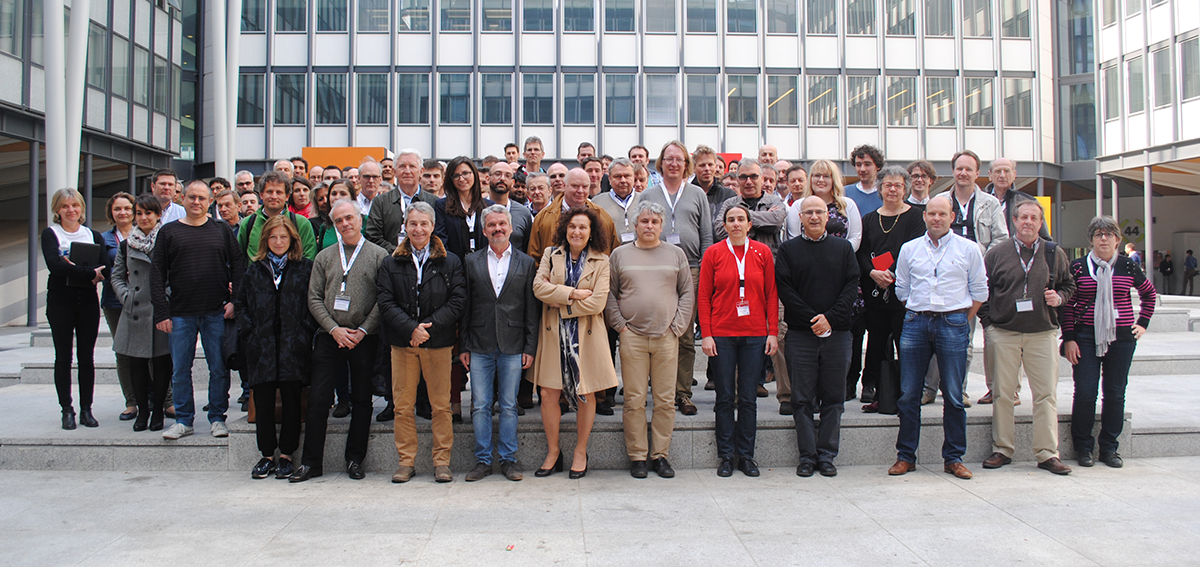AIDA-2020 spearheads European detector R&D
Detectors are what makes particle physics an experimental science. Pushing detector technologies and facilities beyond the frontiers of scientific innovation is critical in advancing high-energy physics.
As such, current detectors must be improved and upgraded, whilst new technology, concepts and applications for future detectors need to be developed. The AIDA-2020 (Advanced European Infrastructures for Detectors at Accelerators) project, coordinated by CERN, aims to bring together the European detector community to tackle those challenges and secure the future of detector science.
To do this, AIDA-2020 aims to enhance detector technology and facilities available in Europe, strengthen its links with both academia and industry, and boost the training opportunities for early career researchers.

Attendees of the AIDA-2020 second Annual Meeting in Paris, 4-7th April 2017 (Image: CNRS-LPNHE)
AIDA-2020 reached the end of its second year of work, the midway point of its four-year duration, in April 2017. At this point, the project members have been able to produce an increasing number of tangible results and achievements, most of which were presented at the project’s second Annual Meeting in Paris, France.
International and inter-disciplinary collaboration is the cornerstone of the work programme of AIDA-2020, where researchers from 24 countries across 15 networking, joint research and transnational access activities come together in a shared goal.
In that same spirit, Work Package 2 (WP2), led by a representative of CERN’s Knowledge Transfer (KT) division, organised an ‘Academia meets Industry’ event focused on medical imaging and processing, and spearheaded a ‘Proof-of-Concept’ fund for developing detector technology for wider applications. Both the event and the innovation fund aim to foster interdisciplinary discussions and potentially launch new partnerships with members of industry.
On the more technical side, AIDA-2020 has advanced work on the complex software required to design, simulate, set-up, run and analyse their components and work. WP3, co-organised by members of CERN’s Experimental Physics (EP) Department, has utilised both the DD4HEP and Geant4 software tool-kits to test algorithms and boost the precision and efficiency of the architectural modelling of detector set-ups. In addition, WP5 has made progress on adapting a test beam data acquisition (DAQ) framework to allow use for all detector types, not only for pixel detectors in isolation.
Similarly, the design, production and testing of new chips and sensors for pixel detectors can be traced to multiple WPs. WP4 produced two small-scale chip prototypes and established the feasibility of 65nm technology for a large-scale readout chip, which may be used pixel detectors for the Large Hadron Collider (LHC) and beyond. Whilst WP6 has completed simulations, prototyping, and testing for large-scale High-Voltage CMOS sensors.Advancing the technology in pixel detectors is the primary goal of the project’s WP7, which devised a collaborative plan, across LHC experiments, for the manufacture and testing of multiple sensors. Through the use of simulations, researchers were able to identify the ideal sensor parameters and include these in sensor design. Two 3D sensors are currently in production, and planar sensors with active edges and low-gain avalanche-diode (LGAD) sensors are scheduled for the future.
However, chips and sensors for pixel detectors are but one avenue of interest. Both large-scale cryogenic, tracking and vertex detectors are being investigated within the framework of AIDA-2020. WP8 was able to assess techniques for cryogenic detectors using the 3x1x1m3 detector at CERN, whilst WP9 produced common light-weight mechanics test structures in conjunction with the CERN EP Detector Technology section, and began assembly a test station to help in the evaluation of micro-channel cooling devices.
Indeed, access to the right facilities is crucial for any research and development project. As such, AIDA-2020 offers a Transnational Access programme, which provides support to users wishing to conduct research at eight different facilities across Europe – including multiple facilities at CERN - offering beam, irradiation and detector characterisation testing.
International and interdisciplinary collaboration is key: AIDA-2020 fosters collaboration between its groups, as technology developed by one WP may often be utilised by another. Such is the case for the collaborative effort between WP5 and WP15 to produce a slow-control system for upgrades of test beam facilities at the DESY laboratory, and the chips prepared in WP4 for the pixel detectors developed in WP7.
Additionally, the project features three joint research activities focused on innovative R&D for already advanced detectors and their technology.
The activity concerning the advancement of gas detectors, WP13, designed a miniaturised high voltage power supply and quality control system in addition to prototypes of several structures required for Micro-Pattern Gas Detectors (MPGDs). MPGDs also have applications outside of physics: in medicine, security and the environment
Upgrading the detector infrastructures in Europe may allow even more innovative technologies to be developed in the future. For example, WP14 has constructed new testing stations for new calorimeter elements, using silicon and scintillator technology. Calorimeters are key detector components, which must be enhanced to push forward the frontier of detector science in both current and future colliders, such as the LHC, CLIC and ILC.
Similarly, upgrading and improving the tools and resources provided via European test and irradiation facilities will allow researchers to push the frontier of detector science forward. Due to high demand, a new beam telescope, named AZALEA, has been delivered by WP15 and installed at the CERN Proton Synchrotron facility. In addition, an expansive online database of irradiation facilities has been launched by this WP, with the aim of providing a centralised resource with up to date information on global irradiation facilities.
Only half way through its activities, AIDA-2020 has already produced some key deliverables sure to strengthen its ability to meet its aim of enhancing European detector infrastructures, further progressing related technologies, and ensuring the detector science of today is able to meet the demands of tomorrow.
